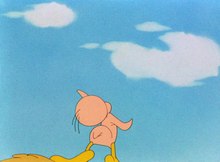A Tale of Two Kitties
| A Tale of Two Kitties | |
|---|---|
 Blue Ribbon reissue title card | |
| Directed by | Robert Clampett |
| Story by | Warren Foster |
| Produced by | Leon Schlesinger |
| Music by | Carl W. Stalling |
| Animation by | Rod Scribner |
| Color process | Technicolor |
Production company | |
| Distributed by | Warner Bros. Pictures |
Release date |
|
Running time | 7 minutes (one reel) |
| Language | English |
A Tale of Two Kitties is a 1942 Warner Bros. Merrie Melodies cartoon directed by Bob Clampett, written by Warren Foster, and features music by Carl W. Stalling.[1] The short was released on November 21, 1942, and features the debut of Tweety, who delivers the line that would become his catchphrase: "I tawt I taw a puddy tat!"[2]
Plot[]
Two cats, Babbit and Catstello, are looking for food to alleviate their hunger. Babbit gets a ladder when they see a bird. Catstello is at first reluctant, but manages to go up the ladder. After several failed attempts, Babbit and Catstello construct a makeshift glider and try to swoop down and catch the bird, but the bird reports an air raid, followed by a blackout, and Catstello is shut down. The bird walks by, and just as Babbit and Catstello are about to catch him, the bird screams at the cats to "TURN OUT THOSE LIGHTS!"
Voice cast[]
- Mel Blanc as Tweety / Catstello
- Tedd Pierce as Babbit
Home media[]
- (1988) VHS - Cartoon Moviestars: Tweety and Sylvester
- (1991) VHS - The Golden Age of Looney Tunes Volume 2: Firsts
- (1991) LaserDisc - The Golden Age of Looney Tunes Volume 1,Side 2: Firsts
- (2005) DVD - They Died With Their Boots On, Blue Ribbon reissue titles, 1995 Turner dubbed version
- (2007) DVD - Looney Tunes Golden Collection: Volume 5, Disc 3
- (2007) DVD - Looney Tunes Spotlight Collection: Volume 5, Disc 2
- (2011) Blu-ray, DVD - Looney Tunes Platinum Collection: Volume 1, Disc 1
- (2020) Streaming - HBO Max
Production notes[]
- This short subject is notable for being Tweety's debut, although the bird was known as Orson in this short, according to the staff. The cartoon was also the first appearance of Babbit and Catstello, based on the popular comedy duo Abbott and Costello. The title is an obvious pun on the Charles Dickens classic, A Tale of Two Cities.
- Even in this initial appearance, Tweety reveals early on that his cute appearance masks a willingness to be merciless, even sadistic, towards anyone who threatens him. After slipping one of the cats a bomb which explodes (offscreen), the bird remarks, "Aw, da poor putty tat—he cwushed his widdow head!" Followed by a big grin. (This line was patterned after a catchphrase from a Red Skelton character, and would be used in other Warner cartoons, such as Easter Yeggs.) This is one of the few Tweety shorts that did not feature his main antagonist Sylvester, who would make his official debut in Life with Feathers (1945).
- A Tale of Two Kitties is remarkable for a clearly adult reference in 1942. Catstello, breaking the fourth wall, takes a direct shot at the Hays Office, making a thinly-veiled reference to giving the middle finger.
- The short was reissued as a Blue Ribbon cartoon on July 31, 1948.[3] Associated Artists Productions acquired the short's distribution rights for television. United Artists, the successor of A.A.P.'s ownership, failed to renew the copyright in time in 1970, so the short is now in the public domain in the United States. As such, it can be found on bootleg home video VHS, DVD, and Blu-ray sets.
- Bugs Bunny would imitate Tweety's "Dis widdow piddy" routine ("I wan outta piddies") in A Hare Grows in Manhattan. Tweety would also reprise this routine with Eddie Valiant (Bob Hoskins) in Who Framed Roger Rabbit.
See also[]
- List of films in the public domain in the United States
- List of animated films in the public domain in the United States
References[]
- ^ Beck, Jerry; Friedwald, Will (1989). Looney Tunes and Merrie Melodies: A Complete Illustrated Guide to the Warner Bros. Cartoons. Henry Holt and Co. p. 135. ISBN 0-8050-0894-2.
- ^ Beck, Jerry (1991). I Tawt I Taw a Puddy Tat: Fifty Years of Sylvester and Tweety. New York: Henry Holt and Co. p. 35. ISBN 0-8050-1644-9.
- ^ Lenburg, Jeff (1999). The Encyclopedia of Animated Cartoons. Checkmark Books. p. 52. ISBN 0-8160-3831-7. Retrieved June 6, 2020.
External links[]
- A Tale of Two Kitties at IMDb
- A Tale of Two Kitties at The Big Cartoon DataBase
- A Tale of Two Kitties on YouTube
- A Tale of Two Kitties at Cinemaniacal
- 1942 films
- English-language films
- 1942 animated films
- 1940s American animated films
- American films
- American animated short films
- Merrie Melodies short films
- Animated films about cats
- Animation based on real people
- Cultural depictions of Abbott and Costello
- Films directed by Bob Clampett
- Warner Bros. Cartoons animated short films
- 1940s Warner Bros. animated short films
